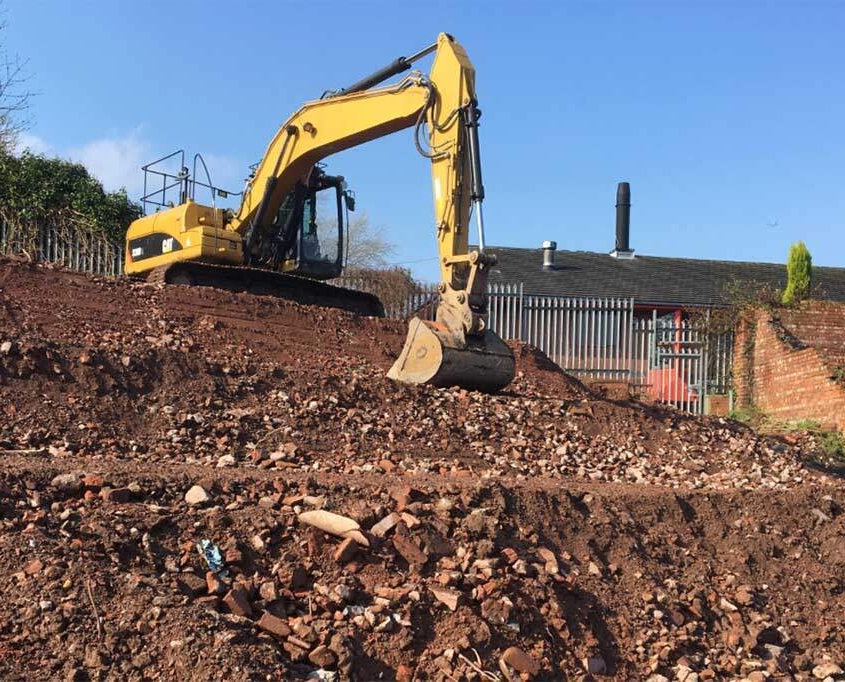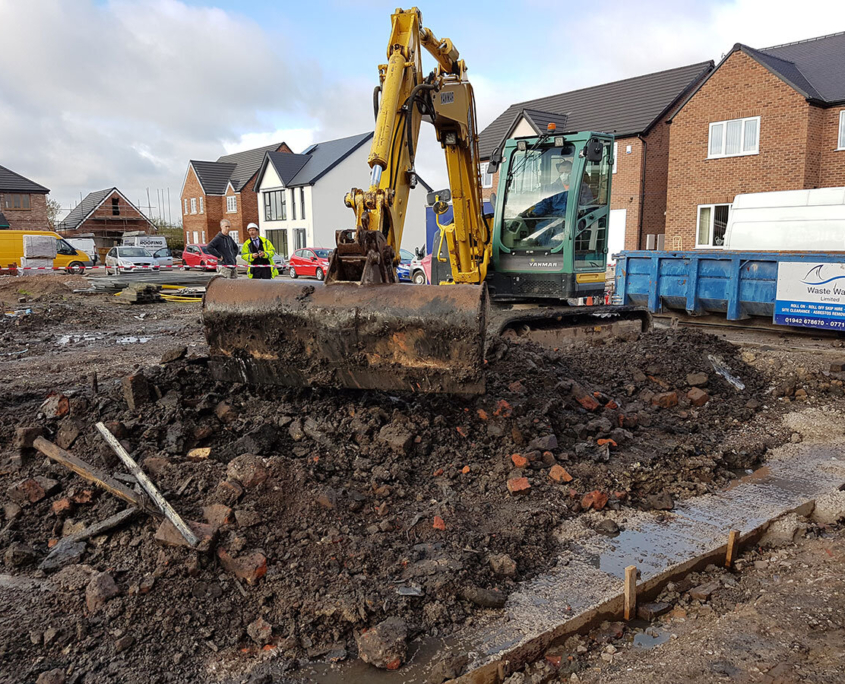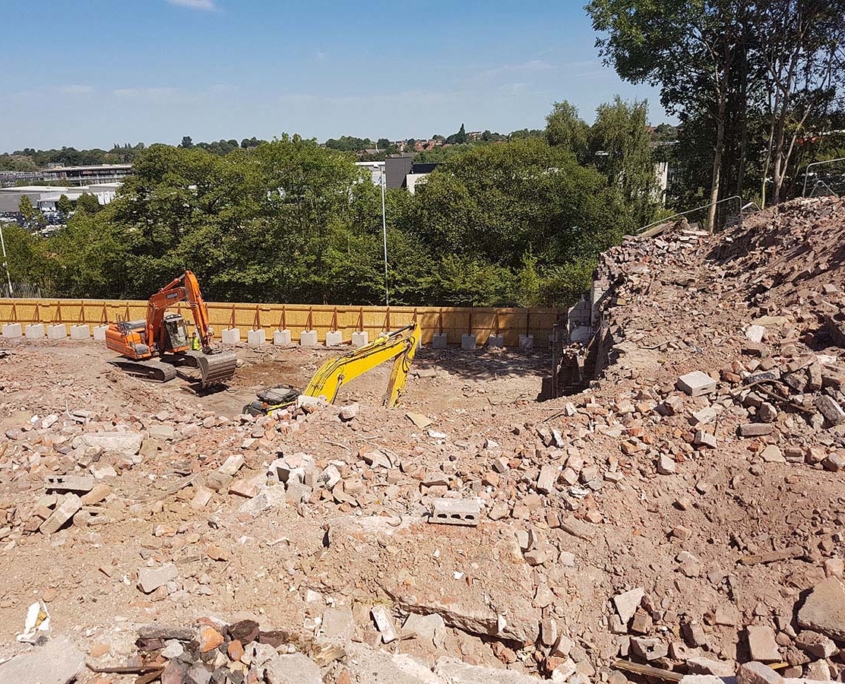Engineered Fill – New standards for NHBC
Engineered Fill – New standards for NHBC
The National House Building Council (NHBC) issued new standards for engineered fill earlier this year. This new chapter 4.6 Engineered Fill gives guidance on meeting the technical requirements and recommendations for using engineered fill to support residential developments external work and infrastructure.
If you are involved in the construction of new housing it is important to understand these new guidelines and how they impact your development site.
The guidance highlights the key following points.
The interaction between engineered fill, ground conditions, and the development is crucial and site-specific.
Main objectives are:
- Ensuring appropriate ground investigation
- Developing geotechnical ground models
- Placing engineered fill according to specifications
- Conducting necessary testing and verification
- Limiting settlement and distortion
- Designing foundations, infrastructure, and external works considering ground conditions and potential hazards
At Earth Environmental & Geotechnical we provide all the services you require at every step of this process including, geotechnical risks, site conditions, pre existing fill assessment, testing, and mitigation. We are known for our cost effective, pragmatic solutions. We identify issues relating to site development early so solutions can be found. We have experience of geotechnically challenging sites, brownfield sites and contaminated land.
As building land immediately suitable for residential developments is limited, more homes are being built or will need to be built on more challenging sites including brownfield land with previous industrial use, former quarries or landfill sites, and greenfield land where remediation or mitigation may be required. Whilst developers may be concerned about the challenges of such sites they should not be deterred. At Earth Environmental & Geotechnical Ltd. we have a wealth of experience and expertise in understanding exactly what your development will be built on and developing cost effective solutions to make your development project a success.
The new guidelines help home builders understand how to safely and successfully build on land working closely with geotechnical experts to design and deliver appropriate foundations for that development site specifically.
The guidance highlights Geotechnical Expertise is essential to understand the interaction between engineered fill, ground conditions, and the developments success.
More Information on Engineered Fill, Technical Requirements and recommendations for using engineered fill to support residential developments, external works, and infrastructures.
What is Engineered Fill?
‘Fill’ refers to a substance utilised for filling depressions or holes in the ground, constructing mounds, or artificially altering ground elevation. It covers various applications such as:
- Earthworks for infilling, raising, or levelling terrain
- Embankments
- Foundation pads
- Landscaping
- Road bases
Fill can be either engineered or non-engineered.
Engineered fill undergoes a selection process, is placed, and compacted according to specific standards to ensure it meets required engineering criteria.
Non-engineered fill typically involves disposing of waste materials. This type of fill is commonly found on sites where uncontrolled filling has occurred, making it unreliable in terms of material type and placement method.
Why is Engineered Fill Important?
The utilisation of engineering fill is increasingly important for construction, civil engineering, and extractive industries. Escalating expenses associated with off-site material removal, particularly the disposal of surplus material, underscore the need to identify the composition and how these materials can be effectively repurposed on-site. Not only is re purposing cost effective but can also be the right environmental choice.
Construction sites often require filling or earthworks for various purposes like flood prevention, drainage improvement, road planning, or achieving suitable ground profiles. Engineered fill may also replace existing ground to support new developments or foundations.
What is covered in 4.6 Engineered Fill Guidance?
This chapter outlines the information necessary for NHBC to ensure proper placement of engineered fill to support low-rise residential buildings, external works, and infrastructure while mitigating risks of settlement or ground failure.
Scope:
- The steps developers need to take if earthworks are proposed on the development
- Importance of understanding exactly what you are building on
- Ground Investigations and detailed interpretive reports are the starting point
- Geotechnical Ground Models Developed to include ground and ground water conditions
- Engineered fill is placed to a suitable earthworks specification
- Differential settlement or excessive settlement of engineered fill should not occur
- Engineered fill and the underlying ground supporting building foundations shall limit building settlements to less than 25mm and minimise angular distortion or tilt to 1:400
- Design and detailing of foundations, infrastructure and external works suit the placed fill and underlying ground conditions taking account of the overall ground model and any geohazards in the ground beneath or nearby
- Geotechnical laboratory acceptability testing and in situ, compliance testing is undertaken and documented, and verification is provided to NHBC
Assessment of historic fill in land reclamation schemes and marginal sites falls outside this chapter’s scope, but our team at Earth Environmental & Geotechnical can assist so please contact us.
The chapter does not cover:
- Backfilling to retaining walls, buried features, or access chambers
- Capping and sub-bases for roads and parking areas
- Filling beneath adoptable highways
- Soil stabilization or piling mats
- Fill containing hazardous substances or used for contamination mitigation
- Use of reinforcing geogrids
Builders are responsible for ensuring compliance with planning and environmental regulations.
The full guidance on meeting the Technical Requirements and recommendations for using engineered fill to support residential developments, external works, and infrastructures can be found here
If you are planning a new development and need geotechnical services contact us now to discuss Geotechnical and Geoenvironmental Services throughout the UK.
From January 2025 NHBC requires all foundations on Engineered Fill to be Compliant with Chapter 4.6
NHBC Chapter 4.6 Highlights the importance of geotechnical investigation, ground models, appropriate lab testing, earthworks specification
Environmental & Geotechnical Consultancy Services Throughout UK
Understanding Ground Conditions is Essential for a Successful Development
More About Earth Environmental & Geotechnical Ltd.
We have worked on a huge array of your sites, from former gasworks, Victorian reservoirs, sewage works, battery storage facilities, renewable energy projects, asbestos factories, electricity sub-stations, collieries, fuel retailing stations, airports, abattoirs, quarries, landfills, etc.
Our services have been used to assist in securing planning pemission and for the the planning and design of new retail stores, housing projects, renewable energy, windfarms solar projects, landfills, quarries, and the restoration of numerous brownfield sites.
We deliver, and take pride in, providing cost effective and pragmatic geotechnical and environmental solutions from our 12 offices in Bath, Cardiff, Edinburgh, Inverness, Stockport, Maidstone, Reading , Exeter, Southampton, Norwich, Birmingham and Wilton.
All of our offices are run by highly experienced Directors, backed by degree qualified staff.
Contact Us now to discuss your project
We have also completed extensive site investigation and ground investigation services in various locations throughout the UK to support new developments and construction
- trial pits
- rotary drilling
- in-situ plate bearing
- Cable Percussive Boreholes
- Window Sample Drilling
- Deep Window Sample Borehole
- Rock Coring
- Rotary Boreholes
- Rotary Core Drilling
- Dynamic Probing
- Trial Pits
- Trenches
- Windowless Sampling Rig
- Soakaway Testing
- Modular windowless sampling drilling rig
- infiltration tests
- ground penetrating radar
- Soil Sampling
- Earthwork Modelling
- Contaminated Land Assessments








